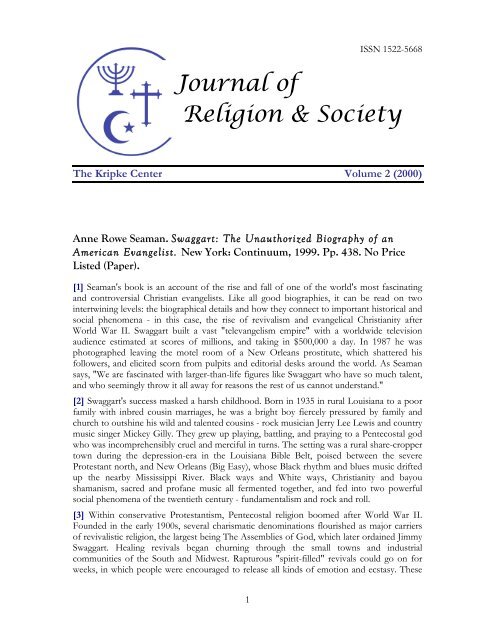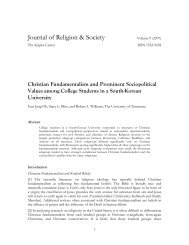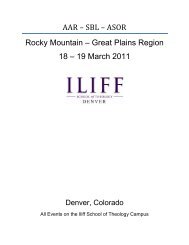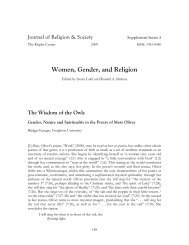Swaggart: The Unauthorized Biography of an American Evangelist
Swaggart: The Unauthorized Biography of an American Evangelist
Swaggart: The Unauthorized Biography of an American Evangelist
Create successful ePaper yourself
Turn your PDF publications into a flip-book with our unique Google optimized e-Paper software.
ISSN 1522-5668<br />
Journal <strong>of</strong><br />
Religion & Society<br />
<strong>The</strong> Kripke Center Volume 2 (2000)<br />
Anne Rowe Seam<strong>an</strong>. <strong>Swaggart</strong>: <strong>The</strong> <strong>Unauthorized</strong> <strong>Biography</strong> <strong>of</strong> <strong>an</strong><br />
Americ<strong>an</strong> Ev<strong>an</strong>gelist. New York: Continuum, 1999. Pp. 438. No Price<br />
Listed (Paper).<br />
[1] Seam<strong>an</strong>'s book is <strong>an</strong> account <strong>of</strong> the rise <strong>an</strong>d fall <strong>of</strong> one <strong>of</strong> the world's most fascinating<br />
<strong>an</strong>d controversial Christi<strong>an</strong> ev<strong>an</strong>gelists. Like all good biographies, it c<strong>an</strong> be read on two<br />
intertwining levels: the biographical details <strong>an</strong>d how they connect to import<strong>an</strong>t historical <strong>an</strong>d<br />
social phenomena - in this case, the rise <strong>of</strong> revivalism <strong>an</strong>d ev<strong>an</strong>gelical Christi<strong>an</strong>ity after<br />
World War II. <strong>Swaggart</strong> built a vast "telev<strong>an</strong>gelism empire" with a worldwide television<br />
audience estimated at scores <strong>of</strong> millions, <strong>an</strong>d taking in $500,000 a day. In 1987 he was<br />
photographed leaving the motel room <strong>of</strong> a New Orle<strong>an</strong>s prostitute, which shattered his<br />
followers, <strong>an</strong>d elicited scorn from pulpits <strong>an</strong>d editorial desks around the world. As Seam<strong>an</strong><br />
says, "We are fascinated with larger-th<strong>an</strong>-life figures like <strong>Swaggart</strong> who have so much talent,<br />
<strong>an</strong>d who seemingly throw it all away for reasons the rest <strong>of</strong> us c<strong>an</strong>not underst<strong>an</strong>d."<br />
[2] <strong>Swaggart</strong>'s success masked a harsh childhood. Born in 1935 in rural Louisi<strong>an</strong>a to a poor<br />
family with inbred cousin marriages, he was a bright boy fiercely pressured by family <strong>an</strong>d<br />
church to outshine his wild <strong>an</strong>d talented cousins - rock musici<strong>an</strong> Jerry Lee Lewis <strong>an</strong>d country<br />
music singer Mickey Gilly. <strong>The</strong>y grew up playing, battling, <strong>an</strong>d praying to a Pentecostal god<br />
who was incomprehensibly cruel <strong>an</strong>d merciful in turns. <strong>The</strong> setting was a rural share-cropper<br />
town during the depression-era in the Louisi<strong>an</strong>a Bible Belt, poised between the severe<br />
Protest<strong>an</strong>t north, <strong>an</strong>d New Orle<strong>an</strong>s (Big Easy), whose Black rhythm <strong>an</strong>d blues music drifted<br />
up the nearby Mississippi River. Black ways <strong>an</strong>d White ways, Christi<strong>an</strong>ity <strong>an</strong>d bayou<br />
sham<strong>an</strong>ism, sacred <strong>an</strong>d pr<strong>of</strong><strong>an</strong>e music all fermented together, <strong>an</strong>d fed into two powerful<br />
social phenomena <strong>of</strong> the twentieth century - fundamentalism <strong>an</strong>d rock <strong>an</strong>d roll.<br />
[3] Within conservative Protest<strong>an</strong>tism, Pentecostal religion boomed after World War II.<br />
Founded in the early 1900s, several charismatic denominations flourished as major carriers<br />
<strong>of</strong> revivalistic religion, the largest being <strong>The</strong> Assemblies <strong>of</strong> God, which later ordained Jimmy<br />
<strong>Swaggart</strong>. Healing revivals beg<strong>an</strong> churning through the small towns <strong>an</strong>d industrial<br />
communities <strong>of</strong> the South <strong>an</strong>d Midwest. Rapturous "spirit-filled" revivals could go on for<br />
weeks, in which people were encouraged to release all kinds <strong>of</strong> emotion <strong>an</strong>d ecstasy. <strong>The</strong>se<br />
1
Book Review<br />
included weeping, falling on the ground, leaping, d<strong>an</strong>cing in states <strong>of</strong> tr<strong>an</strong>sport, <strong>an</strong>d speaking<br />
in incomprehensible tongues - giving Pentecostals the derogatory nickname "holy rollers." In<br />
the mid-twentieth century, the healing touch <strong>an</strong>d casting out demons seemed to have been<br />
passed to Ev<strong>an</strong>gelicals. From small independent Pentecostal ministries came a generation <strong>of</strong><br />
preachers who, with the aid <strong>of</strong> radio <strong>an</strong>d later television, cast <strong>of</strong>f their hometown shackles<br />
<strong>an</strong>d became powers in the larger world.<br />
[4] Jimmy <strong>Swaggart</strong> was one <strong>of</strong> these, <strong>an</strong>d his ev<strong>an</strong>gelical empire grew meteorically. His<br />
rousing music, husky singing voice, <strong>an</strong>d charismatic style drew huge crowds, even in Catholic<br />
countries. Donations rolled in from the faithful, as well as royalties from religious music<br />
records <strong>an</strong>d publications. In addition to grossing $500,000 a day, by the 1980s, his<br />
headquarters in Baton Rouge included a huge auditorium, administrative <strong>of</strong>fices, a<br />
sophisticated media center for editing video tapes, <strong>an</strong> enormous mail center that did so<br />
much business that it had its own zip code, a campground with trailer hookups for the<br />
visiting faithful, <strong>an</strong> elementary school, a high school, a college, <strong>an</strong>d a payroll <strong>of</strong> over 1,500.<br />
<strong>Swaggart</strong>'s was among the competing empires <strong>of</strong> James Bakker (the PTL Club), Jerry Falwell<br />
(the Moral Majority), Oral Roberts, Rex Humbard, <strong>an</strong>d others that grew <strong>an</strong>d competed for<br />
money <strong>an</strong>d audiences.<br />
[5] Such successes had costs. With it came outside attention <strong>an</strong>d critical investigation,<br />
particularly about <strong>Swaggart</strong>'s unremitting <strong>an</strong>ti-Catholicism, <strong>an</strong>d ultraconservative st<strong>an</strong>ces on<br />
religious, social, <strong>an</strong>d moral issues. Most controversial was accountability for the vast inflow<br />
<strong>of</strong> money. Since authority ultimately rested with founder <strong>an</strong>d a few trusted others, there were<br />
few structures for accountability. Such lone ev<strong>an</strong>gelists <strong>of</strong>ten became trapped in a world <strong>of</strong><br />
never-ending practical <strong>an</strong>d org<strong>an</strong>izational decisions they were ill equipped to make. Thus,<br />
decisions in such enterprises <strong>of</strong>ten became arbitrary <strong>an</strong>d disjointed, <strong>an</strong>d it easily appeared<br />
that vast resources were being misused for personal aggr<strong>an</strong>dizement <strong>an</strong>d extravag<strong>an</strong>t living.<br />
[6] Another kind <strong>of</strong> risk for famous Pentecostal leaders was ev<strong>an</strong>gelical religion itself. It was<br />
unforgiving, particularly for its leaders who, like all famous leaders, had little private life. <strong>The</strong><br />
"saved" person - particularly a famous one - was expected to be a perfect moral person. It<br />
left little room for ordinary imperfections or failures <strong>an</strong>d produced enormous guilt -<br />
particularly for traditional sins about booze <strong>an</strong>d sexuality. According to <strong>an</strong> attorney <strong>an</strong>d<br />
minister who followed Jimmy's career for years, ". . . there is no room for failure . . . In<br />
Catholicism you go to confession, admit you sinned, <strong>an</strong>d are forgiven. But in the Pentecostal<br />
Church you're either saved or you ain't. One sin keeps you out . . . when [Jimmy] beg<strong>an</strong><br />
privately battling with [pornography <strong>an</strong>d prostitution], he battled them alone."<br />
[7] When the 1970s sc<strong>an</strong>dals erupted within competing Ev<strong>an</strong>gelical circles, they were about<br />
misuse <strong>of</strong> money, illicit sexuality, materialism, or other moral flaws. <strong>The</strong>y erupted first about<br />
a regionally famous ev<strong>an</strong>gelist (Gorm<strong>an</strong>), <strong>an</strong>d later about the more widely known Jim<br />
Bakker, who, with his wife <strong>an</strong>d partner, were accused <strong>of</strong> all <strong>of</strong> the above. Jimmy <strong>Swaggart</strong>,<br />
Jerry Falwell, <strong>an</strong>d others were called upon to pick <strong>of</strong> the pieces <strong>of</strong> empires ruined by such<br />
disasters, which some viewed as hostile takeovers <strong>of</strong> competitors. Simmering with revenge,<br />
aggrieved ev<strong>an</strong>gelists photographed <strong>Swaggart</strong> emerging from a cheap hotel with a prostitute<br />
in 1987. <strong>Swaggart</strong>'s fall was thus not only caused by hypocrisy <strong>an</strong>d personal failings, but also by bitter<br />
vendettas <strong>an</strong>d rivalries. Though he repented publicly <strong>an</strong>d to the faithful on television ("I have<br />
Journal <strong>of</strong> Religion & Society 2 2 (2000)
Book Review<br />
sinned . . . !") <strong>an</strong>d sought their forgiveness, his empire crumbled but survived, <strong>an</strong>d even<br />
rebounded modestly. But, law enforcement <strong>of</strong>ficials <strong>an</strong>d the press caught him again<br />
patronizing a prostitute while on a trip to California.<br />
[8] <strong>Swaggart</strong>'s ministry still survives, but audiences are a fraction <strong>of</strong> what they once were.<br />
However, the ev<strong>an</strong>gelical subculture with which he was associated <strong>an</strong>d helped to build<br />
thrives. Today it is a political force that casts a large shadow in the Republic<strong>an</strong> Party, in<br />
Congress, <strong>an</strong>d in national politics as a Christi<strong>an</strong> right in issues about welfare reform,<br />
education, <strong>an</strong>d abortion. While reading this book, I kept thinking <strong>of</strong> the parallels (<strong>an</strong>d<br />
differences) with Bill Clinton's impeachment trial.<br />
[9] Seam<strong>an</strong>'s book is a large <strong>an</strong>d thoroughly documented one. As a reader, I must admit to<br />
having a hard time becoming engaged with the book. Some times I felt that the oce<strong>an</strong> <strong>of</strong><br />
biographical details swamped the clarity <strong>of</strong> the other story - about religious trends in<br />
Americ<strong>an</strong> society. But in the end, it is all there, <strong>an</strong>d becomes a fascinating read. Not suitable<br />
for use in classrooms, it would make a good reference book for <strong>an</strong>y library or <strong>an</strong>yone<br />
interested in religion <strong>an</strong>d contemporary Americ<strong>an</strong> society.<br />
Charles L. Harper, Creighton University<br />
Journal <strong>of</strong> Religion & Society 3 2 (2000)







